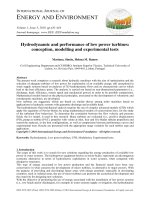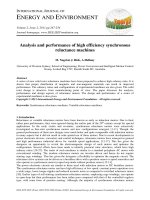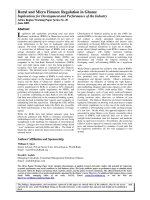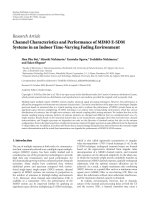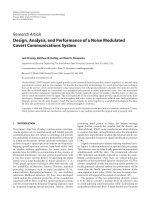Establishment and performance of cactus (Opuntia ficus-indica) accessions at initial stages under shed net in semi-arid region of Rajasthan
Bạn đang xem bản rút gọn của tài liệu. Xem và tải ngay bản đầy đủ của tài liệu tại đây (137 KB, 6 trang )
Int.J.Curr.Microbiol.App.Sci (2019) 8(10): 1983-1988
International Journal of Current Microbiology and Applied Sciences
ISSN: 2319-7706 Volume 8 Number 10 (2019)
Journal homepage:
Original Research Article
/>
Establishment and Performance of Cactus (Opuntia ficus-indica) Accessions
at Initial Stages under Shed Net in Semi-Arid Region of Rajasthan
V. Khandelwal1,3*, M.B. Noor Mohamed1, A.K. Shukla1,
Shamsudheen Mangalassery2 and Devi Dayal2
1
ICAR-Central Arid Zone Research Institute, Regional Research Station, Pali-Marwar,
Rajasthan-306 401 (India)
2
ICAR-Central Arid Zone Research Institute, Regional Research Station, Kukma-Bhuj,
Gujarat-370 105, (India)
3
ICAR-AICRP on Pearl Millet, ARS, AU, Mandor, Jodhpur, Rajasthan- 342 304, (India)
*Corresponding author
ABSTRACT
Keywords
Cactus, Accessions,
Survival rate, SemiArid region
Article Info
Accepted:
15 September 2019
Available Online:
10 October 2019
Cactus (Opuntiaficus-indica), commonly known as prickly pear, belongs to the family
Cactaceae. It has high water-use efficiency, drought tolerant, survive under erratic and low
rainfall and highly useful in arid and semiarid environments, particularly during prolonged
dry spells or failure of the monsoon. Cactus is considered as one of the important sources
of food and fodder to cattle under arid condition. The study has been carried out to
estimate the initial survival rate and establishment of cactus accessions under shed net
condition at ICAR-CAZRI, Regional Research Station, Pali-Marwar. It has shown good
survival rate before rainfall (March-June). But after commencement rainfall (July-August)
it was showing decreasing trend in survival percentage. The survival rate of cladodes
before rainfall ranged between 100% and 40% whereas it was decreased as 80% to 31.4%
after commencement of rainfall. The highest survival percentage of cladodes before
rainfall was recorded in Trunzara Red San Cono, ARL Spineless, Roso Castle Sardo and
Algerian (100%). Out of fifteen accessions, seven were sprouted in 28 to 49 days and
others sprouted after over 50 days. Therefore, waterlogging and saline condition of water
may reduce the survival rate and establishment at initial stage of cactus by causing root rot
under shed net condition.
Introduction
Opuntiaficus-indica (Cactus), commonly
known as prickly pear and belongs to the order
Caryophyllales and the family Cactaceae.
Locally cactus is called nagphani or
dandathohar. Chapathikalliis the common
name of plant used in Tamil Nadu. It is
reported to contain about 130 genera and
nearly 1500 species, which is a new crop in
India although its spiny type, bearing very
small fruits (locally called nagphani) and it is
found wild in arid and semiarid plateau
regions.
Owing
to
its
xerophytic
1983
Int.J.Curr.Microbiol.App.Sci (2019) 8(10): 1983-1988
characteristics and capability for greater
conversion of water to dry matter than by
either C3 or C4 plants through a specialized
photosynthetic
mechanism
called
Crassulacean acid metabolism (Felker et al.,
1997; Mizrahi et al., 1997), it was considered
as a potential crop species for the water-scarce
arid parts of India.
It has a marked capacity to withstand
prolonged drought (Nobel, 1995; Felker et al.,
1997), extreme heat (Sudzuki, 1995), highly
efficient in water use (Nobel, 1995; Snyman,
2004; Snyman, 2005), moderately tolerant to
salinity (Gajendra et al., 2014) and are
considered as an important potential source of
food and fodder (Mishra et al., 2006; Mathur
et al., 2009) in many desert areas of the world.
It is considered as a natural reservoir of water
and may reduce the water requirement of
cattle (Flores-Hernández et al., 2004). Many
species of cactus are found growing as wild
plants in arid (less than 250 mm annual
precipitation) and semi-arid (250-450 mm
annual precipitation) regions of India. In
addition to its remarkable value as cattle and
human food, it can act as biological barrier to
prevent and control top-soil loss (Nefzaoui
and El Mourid, 2009) and increase fodder
availability for animals (Alary et al., 2007).
Opuntias are also important as cover in arid
and semi-arid areas because they can survive
and spread under conditions of scarce and
erratic rainfall and high temperatures and can
play an important role in the protection of
local fauna.
Also, cactus pear has multiple uses. It
produces sweet, nutritionally rich edible fruits,
its tender cladodes are used as fresh green
vegetable and salad, mature cladodes or cactus
stems are used as nutritive fodder for milch
animals (Vishal Nath et al., 1999). The fruit,
as well as cactus stem are used to prepare
value-added products, such as jam, squash,
wine, pickle, body lotions, shampoo, creams,
etc. It also has several medicinal and industrial
uses (Singh and Felker, 1998). The fruit is a
fleshy berry, varying in shape, size, and colour
and has a consistent number of hard seeds.
The fairly high sugar content and low acidity
of the fruit make it very sweet and delicious.
Cacti, and specifically Opuntia spp., have
been extremely useful livestock forage in
times of drought, primarily by providing
digestible energy, water and vitamins.
Although mainly used for cattle, opuntia has
also been used as forage for pigs.
Owing to this importance, it may be
considered as a potential crop species for the
water-scarce arid parts of India. In recent
years, an attention of growing spineless cactus
pear in the drier areas of India in terms of
fruit, fodder and vegetable production is
increasing (Singh and Singh, 2003; Pareek et
al., 2003; Singh, 2006). Therefore, present
investigation has been carried out to estimate
survival rate and initial establishment of
cactus populations (before and after rainfall)
which is collected from different region of
arid zone of India under semi-arid condition of
Rajasthan.
Materials and Methods
The study was conducted on fifteen accessions
of cactus in shade net house condition in
Central Arid Zone Research Institute
(CAZRI), Regional Research Station, PaliMarwar, Rajasthan situated at 25°46′N
longitude and 73°50′E latitude at 225 msl
during the year 2016. The soil is fine sandy
clay loam with high silica content in texture
and alkaline with pH 8.5. Fifteen accessions of
cactus were collected from different region of
arid zones of India and efforts were made to
multiply these accessions in pots. The planting
materials were consisted of two cladodes or
two pieces of a cladode from each clone and it
was weighed prior to planting (200 g to 400
g). The cladodes were dried under partial
1984
Int.J.Curr.Microbiol.App.Sci (2019) 8(10): 1983-1988
shade and treated with Bavistin (0.2%).
Planting was done in cement pots which were
filled with a mixture of farmyard manure and
soil in the month of March. The planting was
done at the depth of 5 cm (1/3rd portion of
cladode) in pots as suggested by Pareek et al.,
(2002). Survival rate and growth of cladodes
were measured before (March to May, 2016)
and after rain fall (July to August, 2016).
Survival Percentage (%) (before and after
rainfall), number of cladodes, days to
sprouting were measured and observations
were recorded.
Results and Discussion
Survival percentage (%) before and after
rainfall
Differences among the accessions were
observed in survival rate of cladodes before
and after rainfall (Table 1). The survival rate
of cladodes before rainfall ranged between
100% and 40%. The highest survival
percentage of cladodes before rainfall was
recorded in Trunzara Red San Cono, ARL
Spineless, Roso Castle Sardo and Algerian
(100%). The accessions from 1271 (40%) and
Bianca Macromer (40%) followed by Piantra25 (67%) and Trunzara Red Bronte (67%) had
lowest survival percentage before rainfall. But
after rainfall the survival percentage was
decreased and it ranged from 80% to 31.4%.
The highest survival rate of the cladodes was
observed in ARL Spineless (80%), Roso San
Cono (80%) and Algerian (80%) whereas
lowest was 1271(31.4%) followed by Bianca
Macromer (37) and 1308 (50%) after rainfall
(Table 1).
Survival rate before rain (March to June-2016)
is better as compare to after commencement of
rain (from July-2016). Because of heavy
rainfall the rotting of cladodes is more. It may
be due to water logging condition in pots. The
infestation of fungus Phytophthora nicotiana
may be more because of favorable climatic
condition. Nallathambi et al., (2005) also
reported that foot rot caused by Phytophthora
nicotianae has been observed as a major
disease in the establishment of cactus pear
(Opunita spp.) under arid conditions. Foot rot
incidence was prevalent in 23.5% of the
germplasm collections during the months of
August and November. Guvera (2001)
suggested that the cactus and other droughttolerant and water-efficient fodder shrubs are
better growing in deep sandy soils under low
rainfall condition (100-150 mm). Gajendra et
al., (2014) also reported that cactus has lower
tolerance to salinity at establishment and
survival stage.
Growth parameters of cactus accessions
Days to sprouting was higher in Piantra-25 (72
days) followed by Roso Castle Sardo (70
days), ARL Spineless and Algerian (69 days)
lower in Trunzara Red San Cono (28 days)
followed by Bianca Macromer (30 days).
Seven accessions sprouted in 28 to 49 days
and others sprouted after over 50 days (Table
1). Under the semiarid conditions of Karnal
(India), the cladodes sprouted after 57 to 100
days after planting (Singh and Felker, 1998).
But, earlier sprouting was occurred at RRS,
Pali-Marwar seems to be related to the warmer
conditions during the month of March.
Number of cladodes per plants ranged
between 6 and 2. Maximum number of
cladodes per plant was observed in 1270 and
1308 (6) followed by Trunzara Red San Cono
(5) whereas minimum was in White San Cono
(2).Singh (2003) and Soni et al., (2015) also
reported higher number of cladodes in
accessions 1270 and 1271. Maximum plant
height was recorded in 1308 (71.8 cm)
followed by 1271 (64.0 cm) and Trunzara Red
San Cono (59.0cm) whereas minimum was
Bianca Macromer (20.5 cm) (Table 2). The
cladodes length of plant varied in different
accessions.
1985
Int.J.Curr.Microbiol.App.Sci (2019) 8(10): 1983-1988
Table.1 Survival percentage and days for sprouting of different cactus accessions
S.No.
1.
2.
3.
4.
5.
6.
7.
8.
9.
10.
11.
12.
13.
14.
15.
Cactus Accessions
1270
1271
CAZRI BOT Garden
1308
Bianca Macromer
Trunzara Red San Cono
Piantra-25
ARL Spineless
Red San Cono
Roso Castle Sardo
Roso San Cono
Algerian
Trunzara Red Bronte
Yellow Rocca Palumba
White San Cono
Survival
Percentage
(%) (Before
Rain)
80
40
80
80
40
100
67
100
85.8
100
80
100
67
80
80
Survival
Percentage
(%) (After
Rain)
60
31.4
55
50
37
60
55
80
57.1
75
80
80
55
66
66
Days for
sprouting
Number of
cladodes
per plant
45
45
46
66
30
28
72
69
50
70
48
69
66
66
49
6
3
3
6
3
5
3
3
4
4
3
3
3
3
2
Table.2 Growth parameters of different cactus accessions
S.No.
Cactus Accessions
1.
2.
1270
1271
3.
4.
5.
6.
7.
8.
9.
10.
11.
12.
13.
14.
15.
CAZRI BOT Garden
1308
Bianca Macromer
Trunzara Red San Cono
Piantra-25
ARL Spineless
Red San Cono
Roso Castle Sardo
Roso San Cono
Algerian
Trunzara Red Bronte
Yellow Rocca Palumba
White San Cono
Number of
cladodes
per plant
6
3
Plant
Height
(cm)
39.5
64.0
Cladode
Length
(cm)
22.20
22.80
Cladode
Width
(cm)
17.0
6.25
Cladode
Thickness
(cm)
1.32
0.65
3
6
3
5
3
3
4
4
3
3
3
3
2
39.5
71.8
20.5
59.0
54.5
40.0
46.0
36.0
53.3
51.0
51.0
31.0
47.0
25.60
19.06
17.50
18.70
26.00
20.20
18.40
13.25
23.15
13.00
20.00
20.25
16.50
8.85
4.03
5.20
6.76
7.36
6.13
5.10
6.65
4.85
4.63
6.25
5.40
4.70
0.90
0.90
0.50
0.56
0.86
0.60
0.40
0.40
0.55
0.63
0.65
0.55
0.50
1986
Int.J.Curr.Microbiol.App.Sci (2019) 8(10): 1983-1988
The accession Piantra-25 recorded the
maximum (26.0 cm) length followed by the
accession CAZRI BOT Garden (25.60 cm).
The Length of cladodes was minimum in
accession Algerian (13.0 cm) followed by
Roso Castle Sardo (13.25 cm) (Table 2).
Maximum width of cladode (17.0 cm) was
attained by the accession 1270 followed by
CAZRI BOT Garden (8.85 cm). Minimum
cladode width (4.03 cm) was recorded in
accession 1308 (Table 2). Regarding cladodes
thickness, it was observed that the accession
1270, CAZRI BOT Garden and 1270 had the
largest cladode thickness of 1.32 cm, 0.90 cm
and 0.90 cm., respectively (Table 2). The
lowest cladode thickness (4.9 cm) was
observed in the accession Red San Cono (0.40
cm) followed by Roso Castle Sardo (0.40
cm). Such variation in size of cladodes has
also been reported from Phaltan in southern
India (Anon., 1993), CAZRI, RRS, Bikaner
(Soniet al., 2015) and Agra in central India
(Singh, 2000).
References
Alary, V., Nefzaoui, A. and Ben Jemaa, M.
2007. Promoting the adoption of natural
resource management technology in
arid and semi-arid areas: modeling the
impact of spineless cactus in alley
cropping
in
Central
Tunisia.
Agroforestry Systems. 94: 573-585.
Anonymous. 1993. Genetic selection and
improvement of Opuntia cultivars for
human and animal food on semi-arid
lands. Final Project Report, Nimbkar
Agricultural Research Institute, Phaltan
(Maharashtra), India. p. 89.
Felker, P., Gurbachan Singh and Pareek, O. P.
1997. Opportunities for development of
Cactus (Opuntia spp.) in arid and semiarid regions. Annals of AridZone.36:
267-278.
Flores-Hernández, A., Orona-Castillo, I.,
Murillo-Amador, B., Garcia-Hernandez,
J. L. and Troyo-Dieguez, E. 2004. Yield
and physiological traits of prickly pear
cactus ‘nopal’ (Opuntia spp.) cultivars
under drip irrigation. Agricultural
WaterManagement.70: 97–107.
Gajendra, G., Gurbachan Singh, Dagar, J. C.,
Khajanchi Lal and Yadav, R. K. 2014.
Performance of edible cactus (Opuntia
ficus-indica) in saline environments.
Indian
Journal
of
Agricultural
Sciences.84: 509-513.
Mathur, B. K., Patil, N. V., Mathur, A. C.,
Meghwal, P. R., and Bohra, R.C. 2009.
Effect of feeding rich resource thornless
cactus (Opuntia ficus-indica) to
Tharparkar cattle in arid region. In:
Proc. International Conference on
Nurturing Arid Zones for People and
the Environment: Issue and Agenda for
the 21stCentury (November 24-28,
2009), Central Arid Zone Research
Institute, Jodhpur, p.271.
Mishra, A. K., Mishra, A. S., Tripathi, M. K.,
Chaturvedi,
O.
H.,Vaithiyanathan,
Prasad, R. and Jakhmola, R.C.2006.
Intake, digestion and microbial protein
synthesis in sheep on hay supplemented
with prickly pear cactus [Opuntiaficusindica(L.) Mill.]with or without
groundnut
meal.
Small
RuminantResearch.63: 125-134.
Nallathambi, P., Umamaheshwari, C. and
Singh,
R.S.
2005.Foot
rot
(Phytophthora nicotianae) in cactus
pear (Opuntia spp.) genotypes under
arid conditions. Annals of Arid Zone. 44
(1): 59-63.
Mizrahi, Y., Nerd, A., and Nobel, P.S. 1997.
Cacti as crops. Horticultural Review.
18: 291-346.
Nefzaoui, A. and El Mourid, M. 2009. Cacti:
A key-stonecrop for the development of
marginal lands and to combat
desertification. In: F.A.P. Campos,
J.C.B. Dubeux Jr. and S. de Melo Silva
(eds.)
Proc.
Sixth
International
1987
Int.J.Curr.Microbiol.App.Sci (2019) 8(10): 1983-1988
Congress on Cactus Pear and
Cochineal. Acta Horticulture.11: 365374.
Nobel, P.S. 1995. Environmental biology. In:
G. Barbera, P. Inglese and E. PimientaBarrios (eds.) Agroecology, Cultivation
and Uses of Cactus Pear. FAO Plant
Production and Protection Paper 132.
FAO, Rome. pp. 213.
Pareek, O.P., Singh, R.S. and Vashishtha.
B.B. 2003. Performance of cactus pear
[Opuntiaficus-indica(L.) Mill.] clones
in hot arid region of India. Journal of
Professional Association of Cactus
Development.5: 121-130.
Singh, R.S. 2000. Studies on propagation and
growth behaviour in cactus pear
(Opuntiaficus-indica(L.)
Mill.)
as
affected by size and age of cladode,
season and methods of planting and
growth regulators. Ph.D. thesis, Dr.
B.R. Ambedkar University, Agra, India.
Singh, Gurbachan. 2006. An overview of
cactus pear research and development in
India. Acta Horticulture (ISHS). 728:
43-50.
Singh, G.B. and Felker, P. 1998. Cacti: a new
world food. Indian Horticulture. 43:2629.
Singh, R. S. and Singh, V. 2003. Growth and
development influenced by size, age,
and planting methods of cladodes in
cactus pear (Opuntiaficus-indica(L.)
Mill.).
Journal
of
Professional
Association of Cactus Development.5:
47-54.
Soni, M. L., Yadava, N. D., Suresh Kumar
and Roy, M. M. 2015. Evaluation for
growth and yield performance of
prickly pear cactus (Opuntiaficus-indica
(L.) Mill) accessions in hot arid region
of Bikaner, India. Range Mgmt. &
Agroforestry.36 (1): 19-25
Snyman, H. A., 2004. Effect of various water
applications on root development of
Opuntiaficus-indica and O.robusta
under greenhouse growth conditions.
Journal of Professional Association of
CactusDevelopment.6: 35–61.
Snyman, H. A., 2005. A case study on in situ
rooting
profiles
and
water-use
efficiency of cactus pears, Opuntiaficusindica and O. robusta. Journal of
Professional Association of Cactus
Development.7: 1–21.
Vishal Nath, Singh. R.S., Shukla, A.K. and
Vashishtha.
1999.
Cactus
pear
(Opuntiaficus indica Mill.) as an
emerging fruit crop for arid and semiarid regions of India. Curr. Agric. 23(12): 49-58.
How to cite this article:
Khandelwal, V., M.B. Noor Mohamed, A.K. Shukla, Shamsudheen Mangalassery and Devi
Dayal. 2019. Establishment and Performance of Cactus (Opuntia ficus-indica) Accessions at
Initial Stages under Shed Net in Semi-Arid Region of Rajasthan. Int.J.Curr.Microbiol.App.Sci.
8(10): 1983-1988. doi: />
1988
